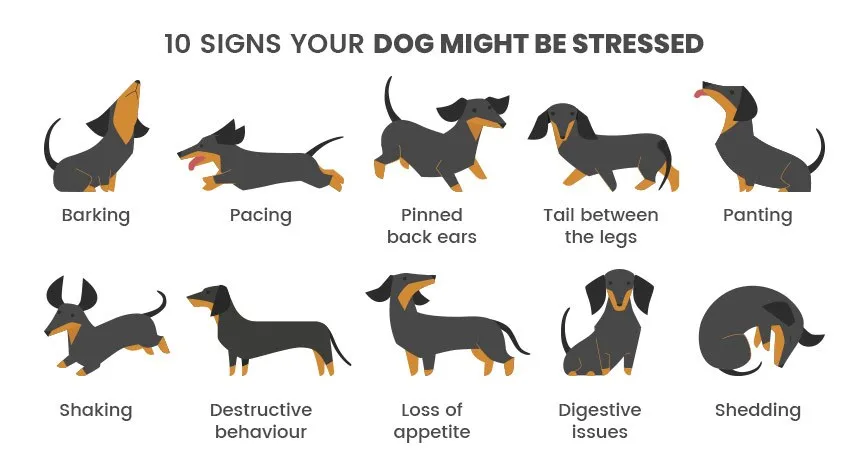10 Signs Your Dog Might Be Stressed
No loving pet owner wants their loyal furry friend to be stressed or anxious, but how can you tell? For many people, it can be hard to spot some of the key signs of stress in dogs and many can easily be confused with other emotions. Unfortunately, our dogs cannot directly speak to us, so to know how they’re feeling you need to be in tune with their body language and actions. To help you look after your nervous dog, here are 10 signs your dog might be stressed so you can better understand your dog’s anxiety and behaviour.
What causes stress in dogs?
Stress and anxiety in dogs can be caused by a number of reasons. In general, there are some common triggers that can lead to a nervous dog. This includes separation anxiety, loud noises, moving house, travelling, going to the vets and meeting new people or pets. When it comes to dogs in distress though, it is important to remember that every pooch is different. Each dog is unique and special in their own right, so what might be a stress trigger for one, may not be for another. Furthermore, what may cause a small amount of anxiety in one dog, may hugely raise the stress levels in another.
Common causes of stress in dogs






Signs of stress in dogs
So now you know the causes that can lead your dog to feel fearful and anxiety-ridden, what are the signs? Whilst there are a number of typical (and not so typical) dog stress symptoms, there are ten signs that are the most common. If your dog is feeling anxious, they will usually exhibit one or more of these symptoms to varying degrees.

1. Barking
Excessive barking and also howling, whining and whimpering can all be big tell-tale signs of a stressed dog. Of course, dogs bark for a number of reasons including when they’re happy so if they bark in reaction to one of the causes above or along with another one of these symptoms, then they are most likely feeling fear and stress.

2. Pacing
You often see people pacing back and forth when they feel nervous and the same goes for dogs. Pacing around and not being able to sit still or relax is a big sign that something is on their mind and not right with your pooch. Pacing will also usually be accompanied with other symptoms such as whining or panting.

3. Pinned back ears
Whilst dog ears differ depending on breed, they can all have visible tell-tale signs signalling a nervous dog. When feeling fear or stress, most dogs ears will appear pinned back, meaning they lay flat or pulled back. Knowing your dog well will let you easily tell what their ears look like when they’re happy, sad or anxious.

4. Tail between the legs
A widely known sign of an unhappy or fearful dog is for them to have their tail between their legs. A dog’s tail is a great indicator of their mood; a happy dog will have their tail wagging up high, so as soon as it drops you can tell there is a problem. The tail of a nervous dog may also be straight down or just wagging slowly at the tip.

5. Panting
Dogs pant as a way to cool themselves down when it is hot or after exercise, but if there doesn’t seem to be an obvious reason, then it is most likely a fear response. This is because when they feel anxiety, their heart rate rises and their breathing becomes more rapid. Panting due to stress is often referred to as ‘behavioural panting’.

6. Shaking
Shaking and trembling is a common sign of fear and anxiety in both dogs and people so it is pretty easy to spot. As long as it couldn’t be for another reason, such as the cold, if your dog starts shaking in response to a trigger, they are most likely feeling nervous. Shaking won’t usually be the only sign though and it is usually coupled with others.

7. Destructive behaviour
While destructive behaviour can also be the sign of an untrained dog or a boisterous pooch, it can also be a sign of a stressed dog. This is because they feel the need to chew on things in order to relieve the tension. Destructive behaviours usually happen as a result of dogs being left alone (separation anxiety) or meeting new pets or people.

8. Loss of appetite
Any time a dog goes off their food there is usually something wrong. Unlike us, our furry friends will eat pretty much anything and everything when they’re feeling happy and carefree. As a result, it is important to avoid stressful situations if it can cause your pet to stop eating.

9. Digestive issues
Gastrointestinal issues including constipation and diarrhoea, as well as vomiting, can widely be brought about as a result of stress. If your dog is feeling anxious, especially for a long time, it can lead to an upset stomach. This is why many calming remedies contain soothing ingredients such as ginger or chamomile to help their mood and tummies!

10. Shedding
Shedding and other issues with a dog’s skin and fur can be a long-term symptom of anxiety. Many people say stress is causing their hair to fall out, and this can also be the same for our nervous dogs. Excessive shedding isn’t usually a response to sudden stress such as a loud noise, but an ongoing stressful situation such as moving.
Other dog stress symptoms
There can also be some other signs of stress in dogs that are considered either less common or more specific to certain situations. This includes avoidance or isolation, licking their mouth or nose, yawning, itching, scratching, excessive drooling and aggression. There may also be others specific to your dog, so the best way to know the symptoms is to watch them and understand them!
How to help a stressed dog
If your dog is showing any of these signs and you think they may be feeling stressed, there are some ways to help!
- Regular Exercise - Going for a walk or playing a game of fetch is a great way to provide some dog stress relief. Doing exercise before a stressful event can also be a great way to make them feel more relaxed and less hyperactive.
- Make them feel safe - Whatever the cause of the stress, create an area that they feel relaxed in, such as their bed area. If possible, you can also try staying with them during the anxious times (such as during a loud fireworks display).
- Diet - What they eat may not seem related, but it can actually have an effect. If your dog isn’t getting enough of something or is lacking vital nutrients, it can impact their whole mood and wellbeing.
- Pet Stress Supplements - Giving your dog a natural supplement designed to help with stress support can help to keep them feeling calm and content. These usually contain soothing ingredients including chamomile and B vitamins.
- Distraction - Keeping your pooch distracted is a great way to keep a nervous dog feeling happy. This can include playing comforting music to block out any noise and leaving them with fun toys that can engage their brains and keep them thinking about something else.

























